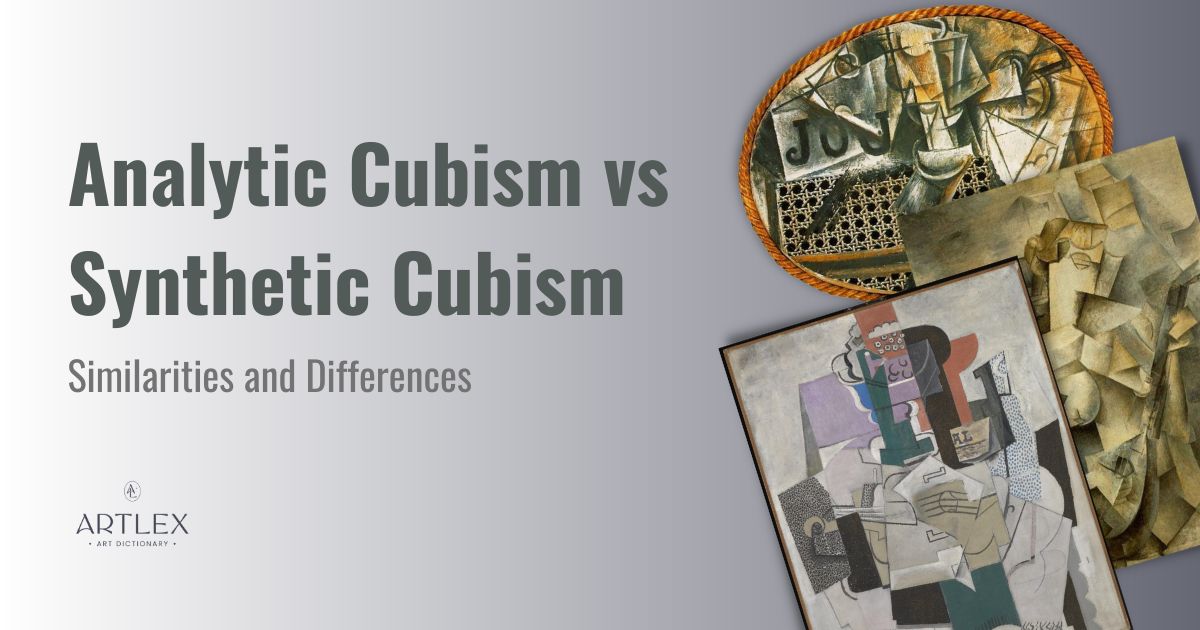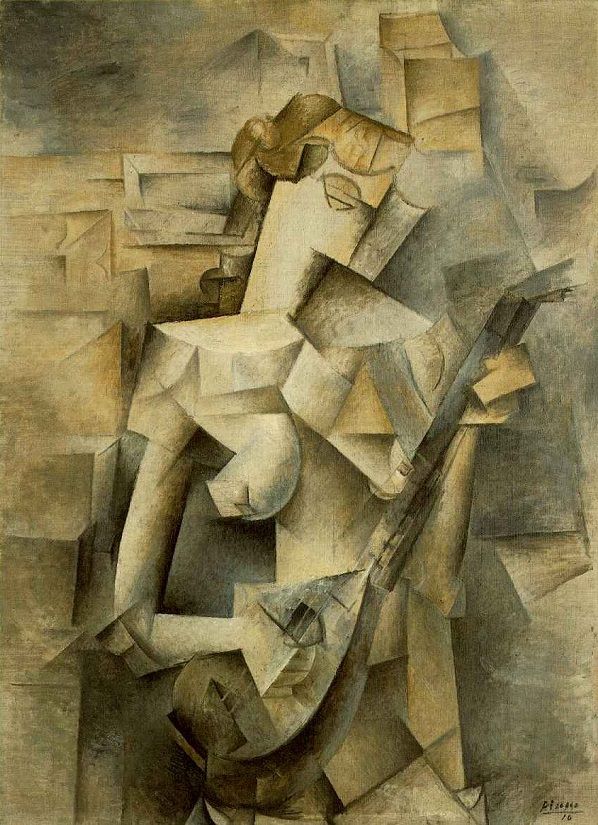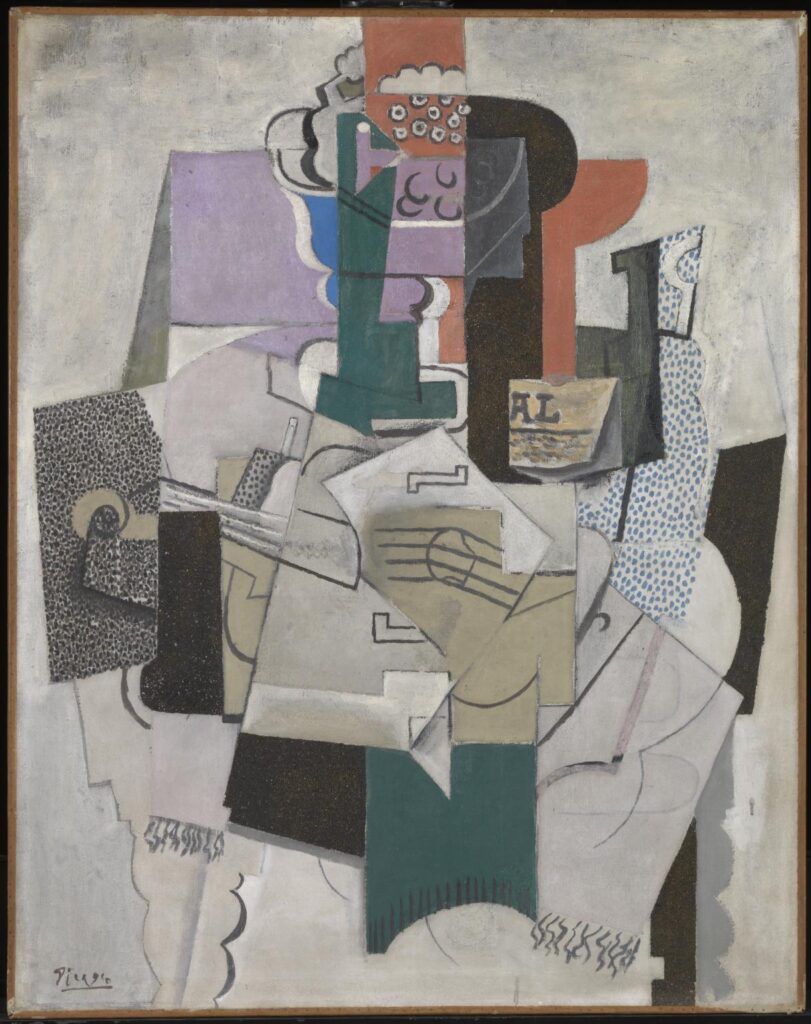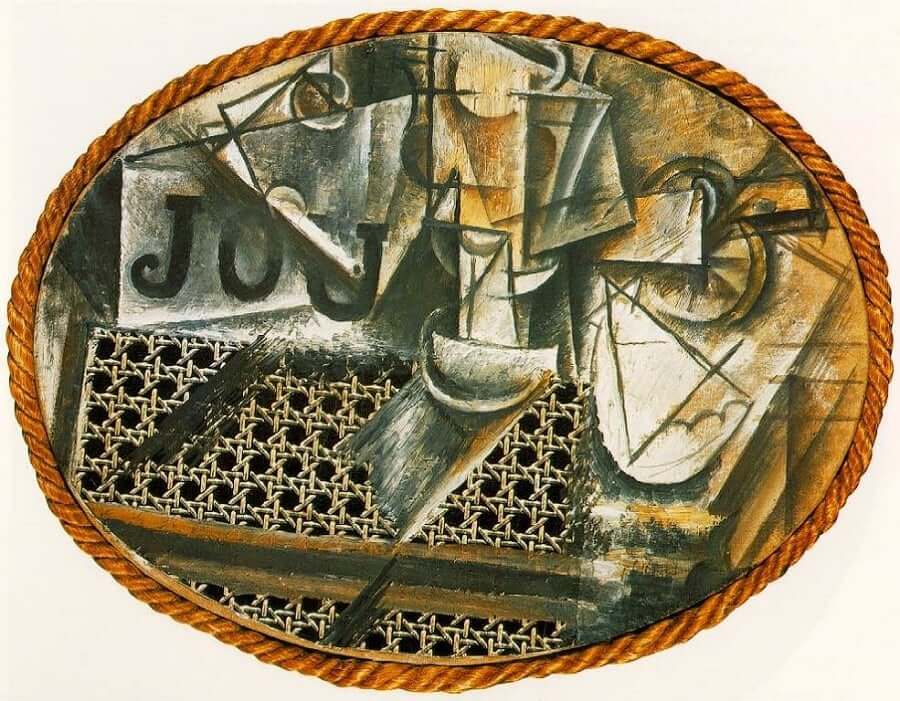
Analytic Cubism and Synthetic Cubism are two major phases of Cubism with many similarities and differences.
Analytic Cubism emerged around 1907 and lasted until 1912. Analytic Cubism is the first official phase of Cubism. Artists working in Analytic Cubism divided the subject into multiple viewpoints and reassembled it into flat, overlapping planes where the subject is visible from different angles. A muted color palette is also commonly seen in Analytic Cubist paintings.
Synthetic Cubism occurred between 1912 and 1914 and is the second major phase of Cubism. Synthetic Cubism also features fragmented subject matter but with a flatter composition, leaving little trace of three-dimensional space. Synthetic Cubism was also about artists experimenting with patterns and textures, adding objects such as newsprint and other paper-based ephemera to their brightly colored paintings.
Analytic Cubism and Synthetic Cubism share many stylistic qualities, such as the use of geometric shapes, various angles and perspectives being simultaneously visible, and an overall flat composition. However, Analytic Cubism and Synthetic Cubism differ in terms of color palette, the use of simple shapes, and variations in materials.
Analytic Cubism and Synthetic Cubism Similarities
Analytic Cubism and Synthetic Cubism are two major phases of the Cubist movement and are very similar despite a clear evolution in style and technique. Three similarities between the Analytic Cubism art movement and Synthetic Cubism art movement include the use of geometric shapes, various angles and perspectives being simultaneously visible, and a flat composition.
Analytic Cubism vs. Synthetic Cubism: Geometric Shapes
Cube-like imagery, as well as other geometric forms like cones, spheres, and cylinders, often appear in Analytic Cubism and Synthetic Cubism. Cubists felt they could portray a subject’s form more accurately by using geometric shapes to represent its various sides and angles simultaneously and with enhanced flatness, as seen in Picasso’s Girl with a Mandolin pictured below:

Analytic Cubism vs. Synthetic Cubism: Various Angles Visible
Cubist artists depicted their subjects from multiple perspectives concurrently, working to represent every angle of the subject on the flat surface of a canvas and within a single picture plane. This technique is visible throughout the phases of Cubism.
Analytic Cubism vs. Synthetic Cubism: Flat Composition
Analytic and Synthetic Cubists rejected illusionistic painting, where the illusion of three-dimensional space is recreated on a flat surface, typically a canvas. Cubists emphasized the two-dimensional quality of a canvas by disassembling and then reassembling the subject matter, piece by piece, with every angle reassembled within a two-dimensional plane.
Cubists thought this method rendered a more honest depiction of reality than that of Renaissance painters.
Analytic Cubism and Synthetic Cubism Differences
There are many differences between Analytic Cubism and Synthetic Cubism, despite both being consecutive phases within the same movement. Three main differences between Analytic Cubism and Synthetic Cubism include color variations, the use of simple shapes, and variations in materials.
Analytic Cubism vs. Synthetic Cubism: Color Palette
Analytic Cubist paintings were largely monochromatic, using dark, earthy tones to represent a subject in space. Synthetic Cubism, on the other hand, featured a slightly more lively color palette including bold reds, blues, yellows, and greens.
This shift in color choice is seen in Picasso’s Bowl of Fruit, Violin, and Bottle, pictured below:

Analytic Cubism vs. Synthetic Cubism: Simple Shapes
Analytic Cubism and Synthetic Cubism also treated shape and form differently. Analytic Cubist paintings were often complex assemblages of shape and form, overlapped to represent the subject. Synthetic Cubist artwork took a more simplistic approach. Artists painted or pasted simple shapes onto the canvas, with fewer overlapping planes and vantage points than Analytic Cubist art.
Analytic Cubism vs. Synthetic Cubism: Materials
Analytic Cubism created a fragmentary image by breaking down an object viewpoint-by-viewpoint and painting each view as a separate, overlapping plane. Synthetic Cubism moved beyond painting, began to incorporate found objects and the papier collé technique, to create a mixed media approach. The latter resulted in an even flatter image, where any trace of allusion to three-dimensional space was gone.
Picasso’s Still Life with Chair Caning, pictured below, uses oilcloth, rope, and chair caning in addition to traditional oil paint:

How did Analytic Cubism Influence Synthetic Cubism?
Analytic Cubism influenced its own evolution into Synthetic Cubism around 1912, when Picasso and Braque began to integrate everyday objects into their paintings. Wallpaper, bottle labels and newspapers were cut and pasted onto flat surfaces, a technique called papier collé, to create multi layered arrangements similar to those of Analytic Cubist paintings. The neutral, earthy color palette of Analytic Cubism also became brighter with a wider variety of hues. Analytic Cubism also influenced the extremely flat style of image that was central to Synthetic Cubism.
Are There Other Forms of Cubism besides Analytical and Synthetic cubism?
Proto-Cubism was the experimental phase between Impressionism and Analytic Cubism that occurred from the start of the 20th century until around 1906. Proto-Cubism is sometimes grouped with Cézanian Cubism, a nod to French Post-Impressionist painter Paul Cézanne’s profound influence on Cubism.
Cézanian Cubism refers to Cézanne’s geometric, angular paintings and the distinctive style that bridged Impressionist style and Cubist style. Cézanne was interested in simplifying natural forms to their geometric foundations using “broken brushwork” and “constructive brushstrokes,” which were common Impressionist techniques.
Cézanne’s method of constructing shapes with fragmented brushstrokes and his analytical approach to painting landscapes impacted Cubists, Fauves, and successive generations of avant-garde artists.
What other Art Movements are Similar to Analytic Cubism and Synthetic Cubism?
The Cubism movement, including both Analytic Cubism and Synthetic Cubism, is one of the most famous and influential Modern art movements of the 20th century. Synthetic Cubism’s lasting influence on twentieth century art is evident in the continued use of collage art and text elements throughout subsequent art movements including Dada, Futurism and Surrealism.
The revolutionary turn to collage, mixed media production, and flattened depictions of subjects using everyday items, initiated by Pablo Picasso and Georges Braque, can be traced from Analytic and Synthetic Cubism all the way through art history to Pop Art and Contemporary Installation Art. The shift to bold and unblended color seen in Synthetic Cubism is often considered to be a precursor to the simple yet vibrant artworks of the Pop Art movement. Overall, Cubism is seen as a precursor to abstract art.
